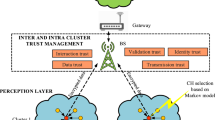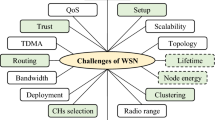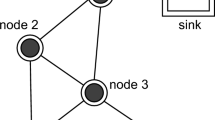Abstract
With the rapid development of cognitive computing and the Internet of Things (IoT), sensing systems have produced a wide range of real-time communication applications. They use 5G/6G-enabled technologies to connect to the outside world to collect data and process different end-user requests. Wireless systems and artificial intelligence (AI) have led to significant development in the optimization process of network communication. Due to various constraints of wireless systems, many solutions have been presented to cope with routing and connectivity concerns. However, topology awareness and attaining management of quality of services are still demanding research challenges for sustainable development. This study proposes an AI-assisted routing model for mobile wireless sensor networks (MWSN) to optimize energy and detect communication link failures. Moreover, the proposed intelligent security approach increases the trustworthiness of the constraint devices on unpredictable routes. Firstly, it explores a genetic algorithm, a metaheuristic optimization technique to determine the feasible solutions, and based on independent metrics it generates an optimal set of routes. In the proposed model, the genetic algorithm provides a fault-tolerant solution for dynamic environments, specifically under unpredictable conditions. Second, new routes are established using dynamic decisions that satisfy the energy considerations. In the end, the proposed model performs regular auditing to detect malicious devices based on unexpected behavior. The proposed model is tested and it outperforms IMD-EACBR and AGRIC in terms of realistic performance metrics.








Similar content being viewed by others

Data availability
No datasets were generated or analysed during the current study.
References
Hazra A, Kalita A, Gurusamy M (2024) Meeting the requirements of internet of things: The promise of edge computing. IEEE Internet Things J 11(5):7474–7498. https://doi.org/10.1109/JIOT.2023.3339492
Muzaffar R, Ahmed M, Sisinni E, Sauter T, Bernhard H-P (2023) 5G deployment models and configuration choices for industrial cyber-physical systems – A state of art overview. IEEE Transactions on Industrial Cyber-Physical Systems 1:236–256. https://doi.org/10.1109/TICPS.2023.3311394
Fowdur TP, Babooram L, Indoonundon M, Murdan AP, Bojkovic ZS, Milovanovic DA (2023) Enabling technologies and applications of 5G/6G-Powered Intelligent Connectivity. In: Driving 5G Mobile communications with Artificial Intelligence towards 6G. CRC Press, pp 355–402
Bhattacharya P, Saraswat D, Dave A, Acharya M, Tanwar S, Sharma G, Davidson IE (2021) Coalition of 6G and blockchain in AR/VR space: challenges and future directions. IEEE Access 9:168455–168484
Salameh HB, Abdel-Razeq S, Al-Obiedollah H (2023) Integration of cognitive radio technology in NOMA-based B5G networks: State of the art, challenges, and enabling technologies. IEEE Access 11:12949–12962. https://doi.org/10.1109/ACCESS.2023.3242645
Hamdan M, Hassan E, Abdelaziz A, Elhigazi A, Mohammed B, Khan S, Vasilakos AV, Marsono MN (2021) A comprehensive survey of load balancing techniques in software-defined network. J Netw Comput Appl 174:102856
Imteaj A, Mamun Ahmed K, Thakker U, Wang S, Li J, Amini MH (2023) Federated learning for resource-constrained IoT devices: Panoramas and state of the art. In: Razavi-Far R, Wang B, Taylor ME, Yang Q (eds) Federated and transfer learning. Adaptation, learning, and optimization, vol 27. Springer, Cham. https://doi.org/10.1007/978-3-031-11748-0_2
Haseeb K, Islam N, Saba T, Rehman A, Mehmood Z (2020) LSDAR: a light-weight structure based data aggregation routing protocol with secure internet of things integrated next-generation sensor networks. Sustain Cities Soc 54:101995
Alahi MEE, Sukkuea A, Tina FW, Nag A, Kurdthongmee W, Suwannarat K, Mukhopadhyay SC (2023) Integration of IoT-enabled technologies and artificial intelligence (AI) for smart city scenario: recent advancements and future trends. Sensors 23(11):5206
Schmitt M (2023) Securing the Digital World: protecting smart infrastructures and digital industries with Artificial Intelligence (AI)-enabled malware and intrusion detection. J Industrial Inform Integr 36:100520
Özkaya U, Seyfi L, Öztürk Ş (2021) Dimension optimization of multi-band microstrip antennas using deep learning methods. Pamukkale Üniversitesi Mühendislik Bilimleri Dergisi 27(2):229–233
Ma B, Guo W, Zhang J (2020) A survey of online data-driven proactive 5G network optimisation using machine learning. IEEE Access 8:35606–35637
Bebortta S, Tripathy SS, Modibbo UM, Ali I (2023) An optimal fog-cloud offloading framework for big data optimization in heterogeneous IoT networks. Decis Analytics J 8:100295
Hussain F, Hassan SA, Hussain R, Hossain E (2020) Machine learning for resource management in cellular and IoT networks: potentials, current solutions, and open challenges. IEEE Commun Surv Tutorials 22(2):1251–1275
Javanmardi S, Shojafar M, Mohammadi R, Alazab M, Caruso AM (2023) An SDN perspective IoT-Fog security: a survey. Comput Netw 229:109732
V S DP, Sethuraman SC, Khan MK (2023) Container security: precaution levels, mitigation strategies, and research perspectives. Comput Secur 135:103490. https://doi.org/10.1016/j.cose.2023.103490
Rehman A, Saba T, Haseeb K, Singh R, Jeon G (2022) Smart health analysis system using regression analysis with iterative hashing for IoT communication networks. Comput Electr Eng 104:108456
Liang Q, Zhao S, Zhang J, Deng H, Damm W, Hess D, Schweda M, Sztipanovits J, Bengler K, Biebl B, Fränzle M (2024) Cyber-physical systems. ACM Trans 8(1). https://doi.org/10.1145/3613531
Peng Y, Jolfaei A, Yu K (2021) A novel real-time deterministic scheduling mechanism in industrial cyber-physical systems for energy internet. IEEE Trans Industr Inf 18(8):5670–5680
Teng SY, Touš M, Leong WD, How BS, Lam HL, Máša V (2021) Recent advances on industrial data-driven energy savings: Digital twins and infrastructures. Renew Sustain Energy Rev 135:110208
Mao B, Tang F, Kawamoto Y, Kato N (2021) AI models for green communications towards 6G. IEEE Commun Surv Tutorials 24(1):210–247
Atik S, Dalyan T (2023) Feature selection optimization with filtering and wrapper methods: two disease classification cases. Turkish J Electr Eng Comput Sci 31(7):1329–1342
Kaveh M, Mesgari MS (2023) Application of meta-heuristic algorithms for training neural networks and deep learning architectures: a comprehensive review. Neural Process Lett 55(4):4519–4622
Zhang R, Chen Y, Dong B, Tian F, Zheng Q (2019) A genetic algorithm-based energy-efficient container placement strategy in CaaS. IEEE Access 7:121360–121373
Patel J, El-Ocla H (2021) Energy efficient routing protocol in sensor networks using genetic algorithm. Sensors 21(21):7060. https://doi.org/10.3390/s21217060
Aruchamy P, Gnanaselvi S, Sowndarya D, Naveenkumar P (2023) An artificial intelligence approach for energy-aware intrusion detection and secure routing in internet of things‐enabled wireless sensor networks. Concurr Comput: Pract Experience 35(23):e7818
Singh S, Kumar D (2023) Energy-efficient secure data fusion scheme for IoT based healthcare system. Future Generation Comput Syst 143:15–29
Pal R, Yadav S, Karnwal R, Aarti (2020) EEWC: energy-efficient weighted clustering method based on genetic algorithm for HWSNs. Complex Intell Syst 6:391–400
Bagwari A, Logeshwaran J, Usha K, Kannadasan R, Alsharif MH, Uthansakul P, Uthansakul M (2023) An enhanced energy optimization model for Industrial Wireless Sensor Networks using machine learning. IEEE Access 11:96343–96362. https://doi.org/10.1109/ACCESS.2023.3311854
Seyyedabbasi A, Kiani F (2020) MAP-ACO: an efficient protocol for multi-agent pathfinding in real-time WSN and decentralized IoT systems. Microprocess Microsyst 79:103325
Lakshmanna K, Subramani N, Alotaibi Y, Alghamdi S, Khalafand OI, Nanda AK (2022) Improved metaheuristic-driven energy-aware cluster-based routing scheme for IoT-assisted wireless sensor networks. Sustainability 14(13):7712
Verma S, Kaur S, Garg S, Sharma AK, Alrashoud M (2024) AGRIC: Artificial-Intelligence-Based Green Routing for Industrial Cyber-Physical System Pertaining to Extreme Environment. IEEE Internet of Things J 11(3):3749–3756. https://doi.org/10.1109/JIOT.2023.3316269
Acknowledgements
This research was supported by the Artificial Intelligence & Data Analytics (AIDA) lab CCIS Prince Sultan University, Riyadh, Saudi Arabia. Authors are thanked for their support.
The author, Fahad F. Alruwaili, would like to thank the Deanship of Scientific Research at Shaqra University for supporting this research.
Author information
Authors and Affiliations
Contributions
KH contributed in Conceptualization, Data curation, Methodology writing; FA involved in Methodology, Resources, review & editing; AK contributed in Data curation, analysis, Resources, Writing – original draft; TA involved in analysis, review & editing; AW involved in Conceptualization, Data curation, software review; AK involved in Conceptualization, Methodology, Software and review. All authors had approved the final version.
Corresponding author
Ethics declarations
Competing interests
The authors declare no competing interests.
Additional information
Publisher’s Note
Springer Nature remains neutral with regard to jurisdictional claims in published maps and institutional affiliations.
Rights and permissions
Springer Nature or its licensor (e.g. a society or other partner) holds exclusive rights to this article under a publishing agreement with the author(s) or other rightsholder(s); author self-archiving of the accepted manuscript version of this article is solely governed by the terms of such publishing agreement and applicable law.
About this article
Cite this article
Haseeb, K., Alruwaili, F.F., Khan, A. et al. AI Assisted Energy Optimized Sustainable Model for Secured Routing in Mobile Wireless Sensor Network. Mobile Netw Appl (2024). https://doi.org/10.1007/s11036-024-02327-7
Accepted:
Published:
DOI: https://doi.org/10.1007/s11036-024-02327-7



